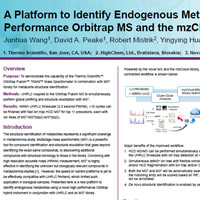
A Platform to Identify Endogenous Metabolites Using a Novel High Performance Orbitrap MS and the mzCloud Library Authors: Junhua Wang1, David A. Peake1, Robert Mistrik2, Yingying Huang1, Gabriel D. T. Araujo3 Email (gabriel.duarte@novanalitica.com.br) 1Thermo Fisher Scientific, San Jose, CA, USA; 2HighChem, Ltd., Bratislava, Slovakia; 3Nova Analítica, São Paulo, SP, BR |
Resumo do Pôster:The structural identification of metabolites represents a significant challenge in metabolomics study. Multistage mass spectrometry (MSn) is a powerful tool for compound identification and structural elucidation that goes beyond identifying the exact same compounds, to discovering additional compounds with structural homology to those in the library. Combining with high resolution accurate mass (HRAM) measurement, MSn is highly effective in identifying the unknown but biologically relevant compounds in metabolomics studies [1]. However, the major problems associated with this methodology are the instrumentation and MS/MS library limitations. The speed on current platforms is yet to be effectively compatible with UHPLC front end, which limited such application in biological samples. The purpose of this work is to demonstrate the capability of a new Orbitrap hybrid system coupled to UHPLC to simultaneously perform endogenous metabolite global profiling and structural elucidation with MSn. This hybrid instrument is composed by a quadrupole mass filter, a C-Trap, an ultra-high-field Orbitrap mass analyser, an ion-routing multipole and a dual-pressure linear ion trap. This new Orbitrap hybrid MS enables fast parallel data acquisition on a UHPLC timescale with a variety of dissociation choices. CID-HCD, HCD-CID, and HCD-HCD can all be set up as simple as the conventional CID-CID. This complete flexibility facilitates the examination of fragmentation pathways that leads to the most comprehensive structural information. A multistage MS library (mzCloud MSn library) enables the identification of compounds even if they are not in the library, and the fragmental peaks can be annotated [2]. Within UHPLC timescale (2-3 second FWHM), >10 cycles could be finished with fast ion trap HCD MS2 for top 11 precursors, each with ion trees of MS2-MS3(top2)-MS4(top2). With the increasing resolution of the system up to 450,000 (FWHM), all five isotope peaks of L-Methionine were clearly resolved for high fidelity in isotope ratio measurements of metabolites. It is known that for metabolite identification and quantitation in complex samples high resolution is required. With >300,000 resolving power of the system used, D-Glucose (200 μM) and Paraxanthine (1 μM) could be readily separated and quantified. The hybrid MS system used has a built-in internal calibration functionality, the Easy-Internal Calibration that allows metabolite identification be readily done with confidence. References
|
